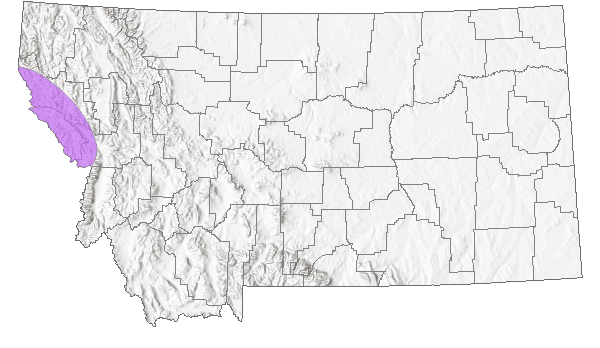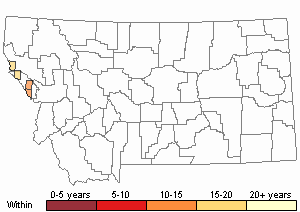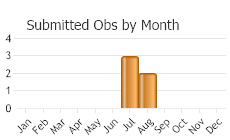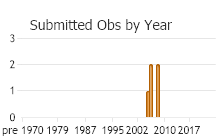View in other NatureServe Network Field Guides
NatureServe
Montana
Utah
Wyoming
Idaho
Wisconsin
British Columbia
South Carolina
Yukon
California
New York
Clearwater Roachfly - Soliperla salish
State Rank Reason (see State Rank above)
The Clearwater Roachfly is currently ranked a "S2" Species of Concern in MT at risk because of very limited and/or potentially declining population numbers, range and/or habitat, making it vulnerable to extirpation in the state.
- Details on Status Ranking and Review
Clearwater Roachfly (Soliperla salish) Conservation Status Review
Review Date = 09/18/2008
Population Size
ScoreU - Unknown
CommentUnknown.
Range Extent
ScoreB - 100-250 km squared (about 40-100 square miles)
Comment<100-250 square km (less than about 40-100 square miles)
Area of Occupancy
Comment40-200 km (25-125 miles) linear river
Length of Occupancy
ScoreLC - 40-200 km (about 25-125 miles)
Long-term Trend
ScoreE - Relatively Stable (±25% change)
CommentSiltation and stream temperature increases with loss of riparian shading and lower snowpack probably contributed to some decline
Short-term Trend
ScoreE - Stable. Population, range, area occupied, and/or number or condition of occurrences unchanged or remaining within ±10% fluctuation
Threats
ScoreF - Widespread, low-severity threat. Threat is of low severity but affects (or would affect) most or a significant portion of the population or area.
CommentClimate Change, increasing stream temperatures and lower snowpack could seriously impact the habitat that this speces exists in
SeverityLow - Low but nontrivial reduction of species population or reversible degradation or reduction of habitat in area affected, with recovery expected in 10-50 years.
ScopeModerate - 20-60% of total population or area affected
ImmediacyLow - Threat is likely to be operational within 5-20 years.
CommentThreat is not fully operational now, but some areas have been lost.
Intrinsic Vulnerability
ScoreB - Moderately Vulnerable. Species exhibits moderate age of maturity, frequency of reproduction, and/or fecundity such that populations generally tend to recover from decreases in abundance over a period of several years (on the order of 5-20 years or 2-5 generations); or species has moderate dispersal capability such that extirpated populations generally become reestablished through natural recolonization (unaided by humans).
Environmental Specificity
ScoreB - Narrow. Specialist. Specific habitat(s) or other abiotic and/or biotic factors (see above) are used or required by the Element, but these key requirements are common and within the generalized range of the species within the area of interest.
CommentCold water stenotherm, cannot survive increases in water temperatures or will have to migrart to cooler temps
General Description
This roach-like stonefly is a regional endemic to the Northern Rocky Mountain Refugium Region centered on the Montana/Idaho border. This species was not collected in Montana before 2001 due to its presence in very small high elevation streams.
Diagnostic Characteristics
Adults are macropterous. General color is yellowish-brown. Wings are clear and veins brown, legs are yellowish brown. Body length is 9-11 mm; forewing length is 12-13 mm. Cerci are small and membranous. Gills are absent. See Stark and Gustafson (2004) for a more detailed description. Larva pre-emergent length is 11-12 mm. General color is light brown, head is light brown with pale thorax and slightly patterned. No PSC1 gills and the posterior thoracic gill number 3 is absent. Nymphs may require 2 years to complete development based on 2 cohorts detected in collections.
Species Range
Montana Range
Range Descriptions

 Native
Native
Range Comments
Rangewide, Soliperla salish is a Northern Rocky Mountain regional endemic known to occur only in Montana and Idaho (Stark and Gustafson 2004). In Idaho, Soliperla salish is known from two locations in Clearwater County and two locations in Shoshone County in the central mountainous part of the state (Clearwater National Forest). In Montana, Soliperla salish has been reported at four locations within the Northern Rocky Mountain Refugium area of Mineral County in western Montana (Stark and Gustafson 2004, Stagliano et al. 2007).
Observations in Montana Natural Heritage Program Database
Number of Observations: 5
(Click on the following maps and charts to see full sized version)
Map Help and Descriptions
Relative Density

Recency



 (Observations spanning multiple months or years are excluded from time charts)
(Observations spanning multiple months or years are excluded from time charts)
Migration
Larval drift and adult movements not studied in Montana.
Habitat
This species occurs in small high gradient creeks and streams near their headwaters source (Stark and Gustafson 2004). Nymphs were found on vertically oriented clean boulders in splash zones or seeping water, but not on the adjacent mossy covered cobbles. Merritt and Cummins (1996) describe Soliperla trophic relationships as shredders and collectors-gatherers (detritus, algae), and Stark and Gustafson (2004) reported shredded organic debris (leaves and wood) in the gut contents they examined.
Food Habits
Stark and Gustafson (2004) reported shredded organic debris (leaves and wood) in the gut contents they examined. Merritt and Cummins (1996) report that members of the family Peltoperlidae are trophically shredder-detritivores, eating large particulate organic materials such as detritus, leaves, and plant materials.
Ecology
Not studied in Montana (but see Habitat comments).
Reproductive Characteristics
In Idaho and Montana, the adults were present late-June through July (Stark and Gustafson 2004).
Management
Soliperla salish has no USFWS status at the present time. Since it is a fairly new species Nature Serve has ranked this species as at risk (G2). Thus, this species is ranked at risk (S2) in Montana but remains unranked in Idaho (SNR).
Threats or Limiting Factors
Specific threats to USFS populations of Soliperla salish have not been identified. A population at Van Ness Creek in Montana is still viable after a forest fire burned through the area, including the riparian zone (D. Gustafson, personal communication). In general, stonefly populations are affected by changes to aquatic habitat, such as alteration of flow patterns, streambed substrate, thermal characteristics, and water quality. Alteration and degradation of riparian/aquatic habitat is the primary concern for Northern Region 1 Forest Service populations.
References
- Literature Cited AboveLegend:
 View Online Publication
View Online Publication Merritt, R.W. and K.W. Cummins. 1996. An introduction to the aquatic insects of North America. 3rd Edition. Kendall/Hunt Publishing Company. Dubuque, Iowa. 862 pp.
Merritt, R.W. and K.W. Cummins. 1996. An introduction to the aquatic insects of North America. 3rd Edition. Kendall/Hunt Publishing Company. Dubuque, Iowa. 862 pp. Stagliano, D.M., G.M. Stephens, and W.R. Bosworth. 2007. Aquatic invertebrate species of concern on USFS northern region lands. Montana Natural Heritage Program, Helena, Montana and Idaho Conservation Data Center, Boise, Idaho. 153 p.
Stagliano, D.M., G.M. Stephens, and W.R. Bosworth. 2007. Aquatic invertebrate species of concern on USFS northern region lands. Montana Natural Heritage Program, Helena, Montana and Idaho Conservation Data Center, Boise, Idaho. 153 p. Stark, B.P. and D.L. Gustafson. 2004. New species and records of Soliperla ricker, 1952 from western North America (Insecta, Plecoptera, Peltoperlidae). Spixiana 27(2):97-105.
Stark, B.P. and D.L. Gustafson. 2004. New species and records of Soliperla ricker, 1952 from western North America (Insecta, Plecoptera, Peltoperlidae). Spixiana 27(2):97-105.
- Web Search Engines for Articles on "Clearwater Roachfly"
- Additional Sources of Information Related to "Insects"





